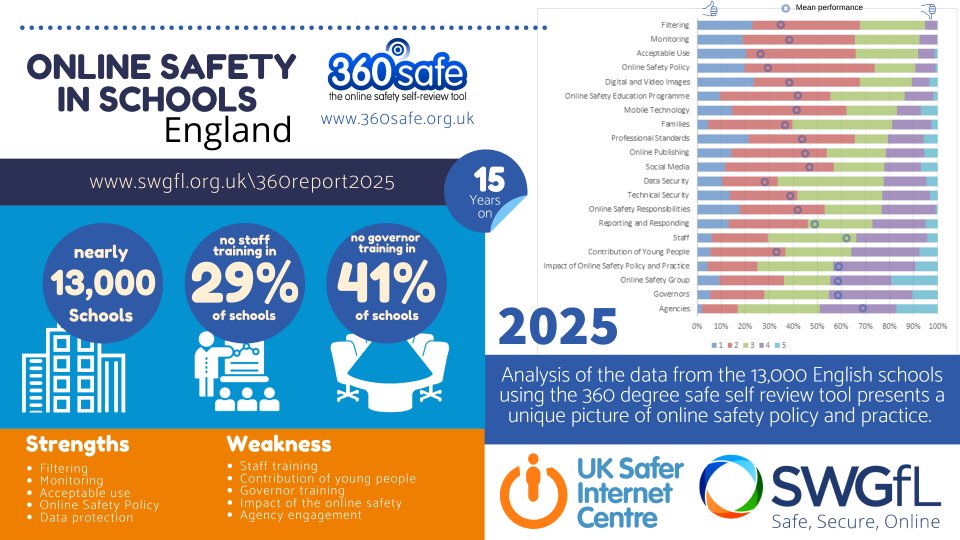SWGfL’s new national analysis of online safety in England’s schools shows steady improvements in digital safeguarding, but also highlights persistent weaknesses in leadership training, community engagement, and collaboration with external agencies.
The England Schools Online Safety Policy & Practice Assessment 2025, prepared by Professor Andy Phippen of Bournemouth University, draws on data from nearly 13,000 schools and colleges using the 360 Degree Safe self-review tool. Developed by SWGfL in 2009, the tool enables schools to evaluate, benchmark, and strengthen their online safety strategies across 21 key aspects, from filtering systems to staff training and governance.
Strong Progress in Technical Safeguards
The report finds that statutory and compliance-driven areas remain the strongest performing. Schools have consistently scored highest in:
- Filtering
- Online Safety Policy
- Acceptable Use
- Digital and Video Images
- Monitoring
These areas reflect the impact of government safeguarding duties and inspection frameworks, which have driven investment in technical systems and written policies.
Weaknesses in Leadership and Engagement
By contrast, aspects requiring cultural change and sustained leadership attention show slower progress. The weakest areas include:
- Agencies – limited collaboration with external organisations
- Online Safety Group – lack of broad stakeholder involvement
- Governors – insufficient training and oversight at governance level
- Impact of Policy – limited evaluation of whether strategies actually work
Alarmingly, almost half of schools report no engagement with external stakeholders around online safety, and nearly 41% provide no online safety training for governors. Even staff training, mandated in safeguarding policy, remains absent in 29% of school
A Cultural Shift Since 2009
Looking at the historical data, the report paints a picture of remarkable progress over the past 15 years. In 2010, over 70% of schools had no staff training in place. By 2025, that figure has greatly improved. Primary schools, once lagging far behind secondary schools in areas such as social media, mobile technology, and technical security, have now closed many of those gaps.
Technical safeguards like filtering and monitoring have changed little, because they were strong from the outset. Instead, the biggest improvements have been in staff development, professional standards, and leadership accountability, showing that schools are shifting from a compliance-based approach to a broader safeguarding culture.
Policy and Practice Looking Ahead
The findings confirm that the 360 Degree Safe tool has been a powerful driver of improvement in online safety. But the report stresses that the next stage of development requires a broader focus.
Professor Andy Phippen concludes that schools must move “beyond compliance-focused technical measures” to build resilience across whole communities. That means:
- Enhancing governor and leadership training
- Embedding systematic staff development
- Strengthening parental engagement
- Involving young people directly in shaping policy
As digital risks continue to evolve, the challenge for schools is no longer just filtering harmful content but ensuring that their culture, leadership, and communities are fully equipped to safeguard children in a connected world.






